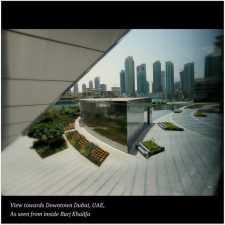 The environment is floundering at best, and people are looking more than ever to put real meaning in their career lives. While he’s overseas and far from the Middle East, Green Prophet talks with John Lehnert (left), an IT specialist and clean tech consultant for Expansion Media, on why he decided to earn a “green” MBA.
The environment is floundering at best, and people are looking more than ever to put real meaning in their career lives. While he’s overseas and far from the Middle East, Green Prophet talks with John Lehnert (left), an IT specialist and clean tech consultant for Expansion Media, on why he decided to earn a “green” MBA.
John’s now at Presidio in San Francisco, considered by environmentalists to offer the best MBA in the world for its MBA in sustainable management. In a recent article Green Prophet has written for the Huffington Post, we awarded it the top of the Top 5 Green MBA’s in the world.
Here’s John’s story on his journey to sustainability (and what he’s learning at Presidio). He’s also provided a partial reading list (for you to steal):
“Once you understand it,” a classmate told me, “it’s like a switch has flipped.” He’s right: you won’t be able to think about anything the way you did before. It’s the foundation of everything we need to do in sustainability and moving to clean energy. The “it” is systems thinking. My own journey to grasp it continues through my MBA program in sustainable management, at Presidio Graduate School in San Francisco.
Getting the MBA wasn’t my original ambition. Working in IT as a team leader and project manager, I’d enjoyed working at small start-ups and large public companies. But I yearned for something closer to my evolving interests, inspired by the development of clean tech and alternative energy in the Bay Area.
Then I discovered Presidio. Here was a program that defined its mission around sustainability, on how to operate a business for more than short-term gains. This resonated with me deeply, and I hoped this program would better enable a transition to the sustainability sector. I started in January 2010.
As befits an MBA program, our curriculum covers business fundamentals: accounting, marketing, operations, economics and finance. But these are all suffused with the perspectives of systems thinking and sustainability. We’re learning how profitability and responsibility can be mutually reinforcing, with several key texts to point the way.
Early on we read what’s become my touchstone: “Thinking in Systems” by Donella Meadows.
Coming from IT, the notion of systems wasn’t new to me (components working together to produce some outcome). But Meadow’s description was illuminating. Systems are everywhere, she explains. Any system contains stocks (a collection of something) and flows (the movement of things within the system). A system can self-organize and adapt if it’s functioning well. If improvement is the goal, it’s essential to think about the inter-relationships of those components and finding points of leverage.
The classic analogy of a bathtub—with a faucet (input) and drain (output) governing the water level (stock)—gives you the insight to understand, for example, why greenhouse gases will continue to accumulate even if we slow down the rate of production. The existing stock (of GHG) is not “draining” fast enough, especially if we destroy the drains (forests).
From a business perspective, you need to think about your processes as systems – and as subsystems with larger ones. This leads, quite elegantly, to thinking of businesses as operating within ecosystems: economic, social, and environmental. And thus to see the whole, the connections and the impacts.
Seeing the interconnection of business and natural resources set the stage for “Natural Capitalism,“ co-authored by our charismatic professor, L. Hunter Lovins.
In our business designs, she writes, we need to add natural capital to the conventional types of capital. In so doing, we are led to consider how we use it, disperse it, deplete it, and—ideally—restore it. The context of nature is essential: if we use it beyond its capacity to perpetually provide, we reach “overshoot” (as Meadows called it).
We can look to natural cycles for examples we can mimic: to efficiently produce a certain output, creating no waste and making only that which can be reused or will contribute to restoration.
Keeping nature in mind, where are we now? In deep trouble, as Lester Brown discusses in “Plan B”. We face looming crises with water availability, environmental degradation, and the interplay of these with poverty, hunger, and even security. But he does not dwell in pessimism and instead outlines a path to sustainability: energy efficiency, moving to renewables and tackling social challenges. Even current technology for solar and wind, he contends, can meet our (restrained) energy needs—so imagine how improved solutions could hasten that transition.
Now we have the thinking, the process tools and the technology to take us down this path. But in the midst of recession-fueled rage and old-school business thinking, can we get there?
Only if we bring others on this journey—which means forging connections based on shared purpose, not just dire warnings. Our communications coursework encouraged us to listen effectively, address underlying needs and then reframe issues to reach common ground. Too often our public discourse seems focused on reinforcing, not resolving conflict. Because our ambitions require more than just enlightened corporate colleagues to achieve, listening and leading in broader communities is essential.
The great reward of this program—with the mindshare of systems thinking—is the regularity with which my old assumptions are disrupted, as I learn how much fundamental change is needed to get the planet healthy again.
This semester, in Operations, we’re talking about industrial ecology, not just assembly lines. In Macroeconomics, we’re considering if our conventional obsession with GDP addresses what’s really important . And in Leadership, we’re considering the assertions that leaders are made, not born, and that the essential task is not merely “execution” but to manage change—mindful of our underlying purpose.
Does that all sound squishy for b-school? Maybe at first glance, but it’s what will work for companies in it for the long haul: looking at systems for impacts and influences, working with stakeholders and not just shareholders, and managing products and services even after they leave the factory or office.
It’s the only way we’ll have the future we want. I’m loving the journey to get there.
 John Lehnert is a consultant for Expansion Media, a PR and SEO firm focused solely on cleantech companies, has served as an IT team leader and project manager for over a decade. In 2010, he started an MBA program in sustainable management at Presidio Graduate School in San Francisco. He has worked at dot-com start-ups and in the IT departments of health care, telecommunications and biotech companies, all in the San Francisco Bay Area. He also helped establish a corporate “green team.” An avid traveler, he has visited 7 continents and 36 countries and recently volunteered at a cloud forest reserve in South America.
John Lehnert is a consultant for Expansion Media, a PR and SEO firm focused solely on cleantech companies, has served as an IT team leader and project manager for over a decade. In 2010, he started an MBA program in sustainable management at Presidio Graduate School in San Francisco. He has worked at dot-com start-ups and in the IT departments of health care, telecommunications and biotech companies, all in the San Francisco Bay Area. He also helped establish a corporate “green team.” An avid traveler, he has visited 7 continents and 36 countries and recently volunteered at a cloud forest reserve in South America.
More good reading on sustainability:
Friedman’s Hot Flat and Crowded (A review on Green Prophet)
McKibben’s “Deep Economy” (A review on Green Prophet)
Werbach’s Strategy for Sustainability (A review on Green Prophet)



I am a writer and instructor at the branch University of New Mexico campus in Taos, NM. Our Green Technology program is dual credit college and high school and offers sustainable building (for which Taos has been a focal point and creative soil for over 30 years). I teach Introduction to Green Business, after starting up a company, running an environmental non-profit and working for many years in media and as an environmental writer and publisher.
I love green MBA reading lists, but mostly for my own teaching needs. I often find a title I haven’t read. Out here on the edge, without a major university in the region, we have small classes with lots of savvy about green versus business-as-usual. I enjoyed the article and enjoyed the comment about networking v. warm fuzzy theory.
My goal this semester is to get students to write a financial plan and work as sustainability consultants in local businesses while learning cradle-to-cradle approaches to business systems.
But I don’t want to churn out consultants, but rather to give students the tools they need to be small business owners with an eye to bioregional and community health. Business owners that might be able to steer our region into a sustainable economy.
For me, the study of sustainable economics is enormously compelling and I share my research with my classes and use it to guide my own business development.
If networking is important to any student, I recommend you look at conferences as your ticket to some high-profile networking. The businesses at LOHAS in Boulder were inspiring to me when I went, but their real life stories of issues such as “exit strategy” were very insightful, and most were open to building their networks with the rabble. At that conference, you can also pitch your product ala star-making TV talent shows (the kind that seemed to worship the put-down as a sign of star power).
The truth is that all colleges and places for higher ed are reaching similar conclusions – you want to be perceived of as the greenest. Still, by trying to be green, like Hamlet’s instructions to his mother, we might well actually become what we say we are. And who knows, maybe that network at Presidio is growing right now because they were top in Huff Post once.
One writer sent me this comment about Presidio and a story I wrote on another blog. I didn’t include his name because he sent a personal message:
HI, just read your Huffington blog on MBA search…I am recent
drop-out from Presidio and wanted to give you another perspective.
Presidio is an inspiring program with really cool, passionate student
body, but it feels like a summer camp a lot of the time….I have
drunk the kool-ade and am a believer in what they are trying to do,
however the most important function an MBA provides is a network and a
quantifiable path to a better job; Presidio does not provide this in
any way. If you have all the connections you need and are only
interested in the experience, it might be a good fit. Otherwise you
can learn what they teach at the library and community college
business courses. The tuition cost does not hold its ROI the same way
a more expensive school like Stanford does with its robust, proven
graduate network.
I really liked the reading list of Hunter Lovin’s intro class on
sustainability, but that’s all it was: a book club.
Anywho…good luck with your search.
While the MBA department at Presidio is certainly the flagship program, it’s a shame that the article didn’t detail Presidio’s competitive edge- being the first integrated graduate school in sustainability. Presidio is not solely a “b-school,” nor a school that offers an MPA degree for business students who want to know more about the public sector. Presidio is the first school in the United States to offer an MPA in sustainable management, and there are a core group of students dedicated to the frontier space of implementing sustainable systems in the public sector. I fear that the description of Presidio paints an inaccurate picture of the Presidio experience.
Yes, article is about the top “Green MBA” degrees and should be focused primarily on the MBA degree, but Presidio stands out as an integrated sustainability graduate school, and is not just a “b-school.”